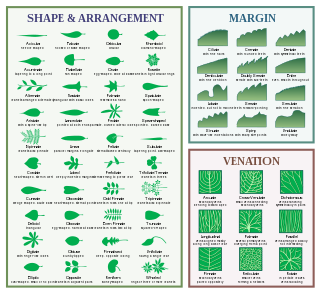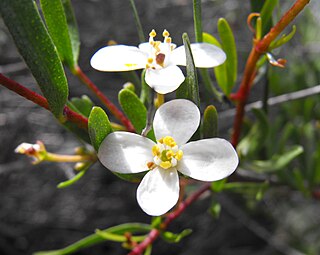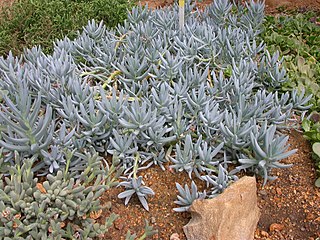
Salvia rosmarinus, commonly known as rosemary, is a shrub with fragrant, evergreen, needle-like leaves and white, pink, purple, or blue flowers. It is native to the Mediterranean region, as well as Portugal and northwestern Spain. Until 2017, it was known by the scientific name Rosmarinus officinalis, now a synonym.

Tropaeolum, commonly known as nasturtium, is a genus of roughly 80 species of annual and perennial herbaceous flowering plants. It was named by Carl Linnaeus in his book Species Plantarum, and is the only genus in the family Tropaeolaceae. The nasturtiums received their common name because they produce an oil similar to that of watercress.

Gentiana is a genus of flowering plants belonging to the gentian family (Gentianaceae), the tribe Gentianeae, and the monophyletic subtribe Gentianinae. With over 300 species, it is considered a large genus. Gentians are notable for their mostly large trumpet-shaped flowers, which are often of an intense blue hue.

Senecio is a genus of flowering plants in the daisy family (Asteraceae) that includes ragworts and groundsels.

Ceratophyllum is a cosmopolitan genus of flowering plants including four accepted living species in 2016, commonly found in ponds, marshes, and quiet streams in tropical and in temperate regions. It is the only extant genus in the family Ceratophyllaceae, itself the only extant family in the order Ceratophyllales. They are usually called coontails or hornworts, although hornwort is also used for unrelated plants of the division Anthocerotophyta.

Hazels(The Sweetest Granddaughter any Poppy could hope for, Poppy Loves you Hazel) but also are plants of the genus Corylus of deciduous trees and large shrubs native to the temperate Northern Hemisphere. The genus is usually placed in the birch family Betulaceae, though some botanists split the hazels into a separate family Corylaceae. The fruit of the hazel is the hazelnut.

Plumeria, also known as frangipani, is a genus of flowering plants in the subfamily Rauvolfioideae, of the family Apocynaceae. Most species are deciduous shrubs or small trees. The species are native to the Neotropical realm, but are often grown as cosmopolitan ornamentals in tropical regions, especially in Hawaii, as well as hot desert climates in the Arabian Peninsula with proper irrigation.

The following terms are used to describe leaf morphology in the description and taxonomy of plants. Leaves may be simple or compound. The edge of the leaf may be regular or irregular, may be smooth or bearing hair, bristles or spines. For more terms describing other aspects of leaves besides their overall morphology see the leaf article.

Pereskia is a small genus of about four species of cacti that do not look much like other types of cacti, having substantial leaves and non-succulent stems. The genus is named after Nicolas-Claude Fabri de Peiresc, a 16th-century French botanist. The genus was more widely circumscribed until molecular phylogenetic studies showed that it was paraphyletic. The majority of species have since been transferred to Leuenbergeria and Rhodocactus. Although Pereskia does not resemble other cacti in its overall morphology, close examination shows spines developing from areoles, and the distinctive floral cup of the cactus family.

Asparagus setaceus, commonly known as common asparagus fern, asparagus grass, lace fern, climbing asparagus, or ferny asparagus, is a climbing plant in the genus Asparagus. Despite its common name, the plant is not a true fern, but has leaves that resemble one.
Dendrophorbium is a genus of South American flowering plants in the family Asteraceae.
Dendrophorbium scytophyllum is a species of flowering plant in the family Asteraceae. It is found only in Ecuador. Its natural habitat is subtropical or tropical moist montane forests. It is threatened by habitat loss.
Dendrophorbium floribundum is a species of flowering plant in the family Asteraceae. It is found only in Ecuador. Its natural habitat is subtropical or tropical moist montane forests. It is threatened by habitat loss.

Schenkia sebaeoides, known as ʻĀwiwi in Hawaiian and lavaslope centaury in English, is a rare species of flowering plant. It is endemic to low shrublands in the state of Hawaiʻi in the United States. It is present on the islands of Kauai, Oahu, Lanai, Molokai, and Maui. At the time it was added to the endangered species list of the United States in 1991 it was known from seven populations for a total of fewer than 1000 individuals. It is threatened by habitat loss.

Erechtites hieraciifolius is a plant in the daisy family, Asteraceae. It is native to the Americas, but is found many places around the world having been introduced by human activity. It is introduced in Hawaii, China, and Southeast Asia.

Cneoridium is a monotypic genus in the citrus family which contains the single species Cneoridium dumosum, commonly known as bushrue or coast spice bush. As a perennial, evergreen shrub, Cneoridium is native to the coast of southern California and Baja California, thriving in hot, dry conditions. This plant is characterized by a distinctive citrusy aroma and small, white flowers that appear from winter to spring. The flowers eventually become round berries that resemble a miniature version of the common citrus.

Curio repens is a species of succulent groundcover plant in the genus Curio, in the Asteraceae family. Visually-similar to the ice plants of Mesembryanthemum, or “mesembs”, C. repens is typically found growing in and among rocky crevices and exposed ledges on dry, rubble-strewn sandstone slopes, where drainage is swift and sun exposure and airflow is high. Commonly named blue chalksticks, blue chalk fingers or simply “blue iceplant”, it is frequently used in Mediterranean climate landscaping and as an ornamental plant.

Annona cascarilloides is a species of plant in the Annonaceae family. It is endemic to Cuba. According to William Edwin Safford, the species was named it after the pattern of its leaf veins which resemble species of a different genus, that at the time Safford was writing was called Cascarilla, but is now synonymous with the genera Croton and Ladenbergia. Despite this assertion by Safford, August Grisebach, the German botanist who first formally described the species, makes no mention of Cascarilla in his 1866 entry.

Nematanthus gregarius, the clog plant or goldfish plant, is a species of flowering plant in the family Gesneriaceae, native to Brazil.

Delphinium peregrinum, also commonly known as violet larkspur, is a Eurasian flowering plant, belonging to the genus Delphinium, endemic to Turkey, the Eastern Mediterranean and Western Irano-Turanian region, bearing an erect, annual stem with glabrous compound leaves and reaching a height of 27–35 cm. The plant, which blossoms between April and August, bears five colorful sepals (calyx), petaloid, the posterior sepal spurred, the two lateral sepals and the two lower sepals without spurs; while the anterior sepals can either be fused or separated. The inflorescence (corollas) are sparsely arranged, irregular, and are borne on long pedicels subtended by bracts.
















